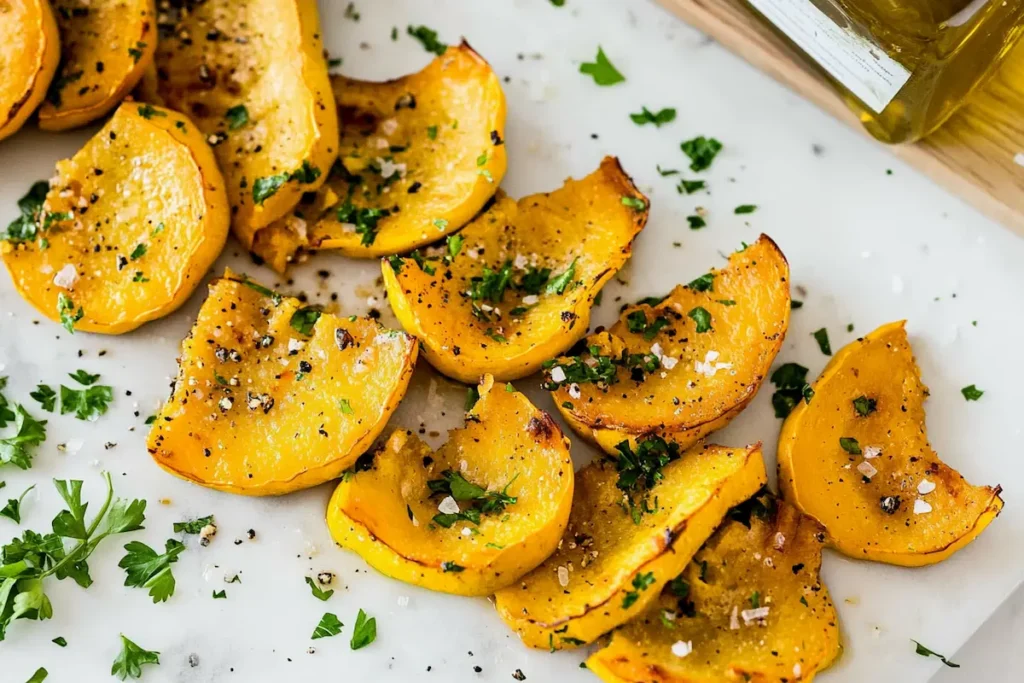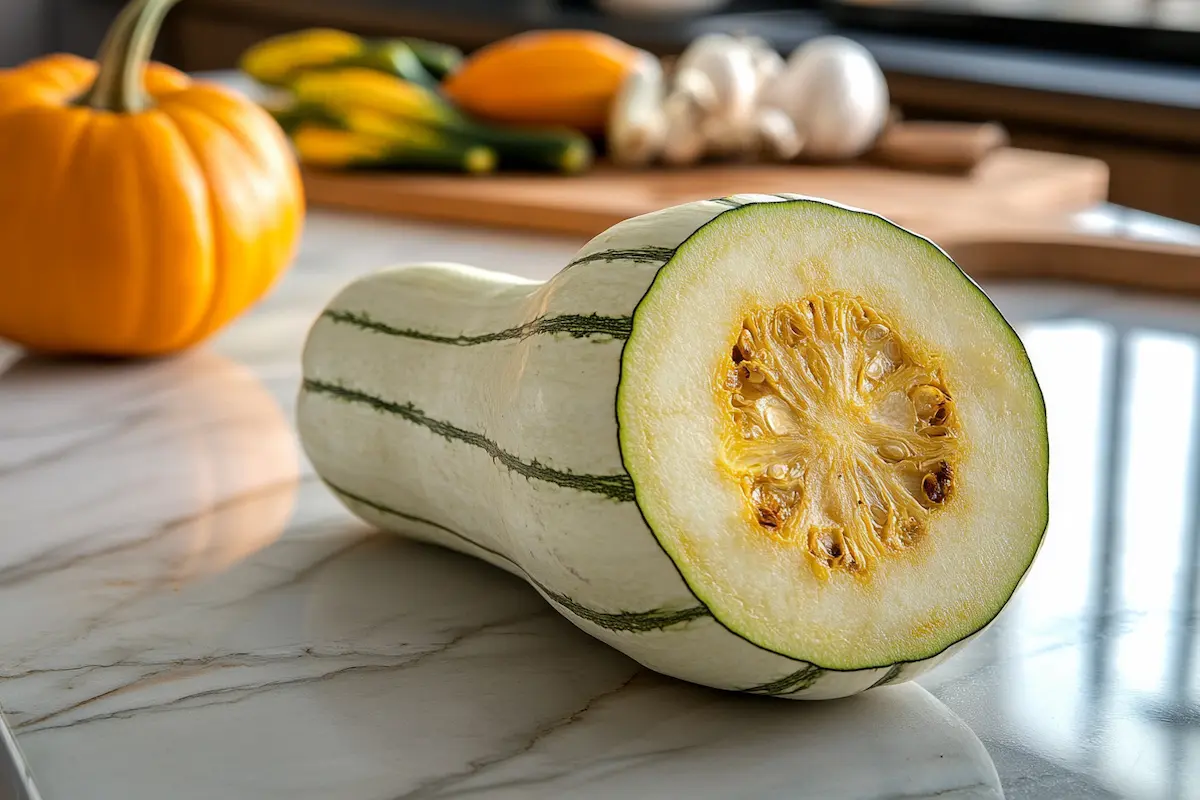Cousa squash has a mild, slightly sweet flavor. This makes it great for various dishes. Let’s explore its unique taste and how to use it.
Understanding the Flavor of Cousa Squash
Cousa squash, often mistaken for zucchini, possesses a delicate taste. Its flavor is notably mild. Cousa squash has a subtly sweet undertone. However, it lacks the more pronounced vegetal notes of other squashes. This subtle flavor profile is very adaptable. Therefore, it can easily absorb other flavors in a recipe. Cousa squash’s gentle nature makes it a good choice for picky eaters. Furthermore, it is also good for those who enjoy simple, clean tastes.
Textural Qualities of Cousa Squash
The texture of cousa squash contributes to its appeal. Cooked cousa squash becomes very tender. It is almost creamy in texture. Therefore, it is very easy to eat. The skin is thin and edible, adding to the pleasing texture. Furthermore, these textural characteristics enable it to blend well with both simple and sophisticated meals. The tender flesh, combined with its subtle taste, makes cousa squash a versatile choice.
Culinary Uses for Cousa Squash
Cousa squash is incredibly versatile. Accordingly, it can be used in many ways. It is great for stuffing, roasting, or grilling. In addition, it is a fine addition to soups and stews. Because of its gentle flavor, it works very well with numerous different spices. Cousa squash makes an excellent side dish. Also, it can be a featured part of main meals. Its mild flavor compliments almost anything you pair it with.
Cousa Squash in Different Cuisines
Around the world, cousa squash is prepared in many unique ways. In Middle Eastern cuisine, it is often stuffed with rice and spices. Cousa squash is known in the Mediterranean for its adaptability. Similarly, it can be used in Italian dishes. For example, it may be added to pasta sauces or simply cooked with garlic and olive oil. These global examples show how easily cousa squash can adapt. Cousa squash is a delightful option for almost any type of cooking.
Simple Roasted Cousa Squash Recipe

Here’s a simple way to enjoy cousa squash: roasting. This method highlights the squash’s natural flavor.
Ingredients:
- 4 cousa squash, cut into 1-inch pieces
- 2 tablespoons olive oil
- 1/2 teaspoon salt
- 1/4 teaspoon black pepper
- 2 cloves garlic, minced
- 1 teaspoon dried herbs (such as oregano or thyme)
Instructions:
- Preheat your oven to 400°F (200°C). In the meantime, prepare the squash by washing it and cutting it into uniform pieces.
- In a large bowl, combine the squash pieces with olive oil, salt, pepper, minced garlic, and dried herbs. Toss thoroughly to ensure that each piece is well coated.
- Spread the seasoned cousa squash pieces in a single layer on a baking sheet. This prevents them from steaming and ensures a good roast.
- Roast in the preheated oven for 20-25 minutes. Turn halfway through cooking. The squash should be tender and slightly browned, with nice crispy edges.
- Once cooked, remove from oven and let it cool slightly before serving. Serve it warm. Enjoy it as a side dish or an addition to other meals.
This recipe is both easy and delicious. It helps you to appreciate the natural taste of cousa squash.
Stuffed Cousa Squash Recipe

Stuffed cousa squash makes a satisfying meal. This version uses simple, tasty components.
Ingredients:
- 6 cousa squash
- 1 cup cooked rice
- 1/2 cup chopped onion
- 2 cloves garlic, minced
- 1/4 cup chopped parsley
- 1/4 cup grated cheese
- 1 tablespoon olive oil
- Salt and pepper to taste
- 1/2 cup vegetable broth
Instructions:
- Preheat your oven to 375°F (190°C). First, prepare the squash by washing them. Then, cut a thin slice off the top of each squash and use a spoon to remove some of the pulp, creating a well for the stuffing. Be careful not to break through the bottom of the squash.
- In a pan, heat olive oil and sauté onion and garlic until softened. Then, add the cooked rice, parsley, cheese, salt, and pepper to the pan. Mix together thoroughly.
- Stuff each squash with the mixture. Be sure to pack the stuffing firmly.
- Place the stuffed squashes in a baking dish. Pour the vegetable broth into the bottom of the dish. This will help to keep the squash moist during cooking.
- Bake in the oven for about 30-40 minutes, or until the squash is tender and the filling is heated through and lightly browned on top.
- Let the stuffed cousa squash cool for a few minutes before serving. This helps the flavors to combine more effectively. This makes a flavorful and satisfying meal.
This recipe highlights the versatility of cousa squash.
Nutritional Information
Cousa squash is not just tasty; it’s also good for you. Additionally, it’s low in calories and contains a number of nutrients.
| Nutrient (per 100g) | Amount |
|---|---|
| Calories | 16 |
| Carbohydrates | 3.5g |
| Protein | 1g |
| Fat | 0.2g |
| Fiber | 1.2g |
| Vitamin C | 12mg |
| Potassium | 261mg |
Want more delicious cousa squash ideas? Check out this detailed recipe guide on Cousa Squash for more tips and variations.
Other Squash Varieties and How They Compare
It’s useful to compare cousa squash to other varieties. This helps in understanding how cousa squash stands out.
Cousa Squash Versus Zucchini
Cousa squash is often confused with zucchini. However, there are key differences. Zucchini has a slightly more pronounced flavor. Comparatively, cousa squash is sweeter. Moreover, cousa squash is usually shorter and rounder. These differences affect how they cook and taste. Therefore, you might pick cousa squash for certain meals over zucchini.
Cousa Squash Versus Yellow Squash
Yellow squash has a more delicate flavor. In addition, its skin is thinner. Cousa squash has a firmer flesh. Yellow squash tends to be more watery. Therefore, cousa squash holds its shape better when cooked. Thus, it might be a superior choice for certain cooking methods.
Cousa Squash Versus Acorn Squash
Acorn squash is quite different. It has a nutty, sweeter flavor and a much harder rind. Acorn squash requires more cooking time. Therefore, cousa squash, with its quick cooking time and mild taste, is the go-to choice when you want something fast and flavorful.
Health Benefits of Cousa Squash
Cousa squash provides several health benefits. It’s a good addition to a well-rounded eating plan.
Low Calories and Good Fiber
Cousa squash is low in calories. This makes it a great choice for those watching their weight. It’s also a source of fiber. Fiber is important for digestion. In addition, it can help you feel full longer. Accordingly, cousa squash is a helpful addition to any weight-management approach.
Source of Important Nutrients
Cousa squash contains nutrients that are important for health. For example, it has Vitamin C. This nutrient helps with immunity. It also contains potassium. Potassium aids in maintaining blood pressure. Furthermore, it offers trace minerals that support well-being.
Aiding Digestion
The fiber in cousa squash helps with digestion. It supports a healthy gut. Also, it can prevent issues, such as constipation. Therefore, including cousa squash in your diet can be very good for gut health. The gentle nature of cousa squash makes it good for those with sensitive stomachs.
Tips for Buying and Storing Cousa Squash
Choosing the right cousa squash can make a difference. Proper storage extends its freshness.
How to Choose Cousa Squash
When buying cousa squash, select those that are firm to the touch. Additionally, the skin should be free of bruises and blemishes. Further, the size should be medium-sized. Therefore, you should avoid buying squashes that are too large. These may have a less appealing texture.
Storing Cousa Squash
Cousa squash should be stored in the refrigerator. It can be stored in the crisper drawer. It is best if consumed within a week of purchase. Therefore, to keep it fresh longer, avoid washing it until you’re ready to use it.
Expanding the Culinary Horizons of Cousa Squash
Beyond roasting and stuffing, there are many more ways to enjoy cousa squash. Its subtle taste and adaptable texture make it very flexible in the kitchen. Let’s delve into some additional cooking methods and creative ideas.
Cousa Squash in Soups and Stews
Cousa squash is a wonderful addition to soups and stews. Its mild flavor doesn’t overpower other ingredients. Instead, it adds a smooth, creamy texture. Furthermore, it absorbs the flavors of broths and spices well. Accordingly, you can add diced cousa squash to your favorite vegetable soup or a hearty stew for added nutrients. Additionally, it works well in both light, broth-based soups and creamy, rich stews.
Grilling Cousa Squash
Grilling cousa squash brings out a slightly smoky flavor, which compliments its natural sweetness. First, slice the squash into rounds or lengthwise. Then, lightly brush with olive oil and season with salt, pepper, and any herbs you enjoy. Afterward, grill over medium heat until tender and lightly charred. Finally, grilled cousa squash makes a great side dish or a tasty addition to salads and wraps.
Cousa Squash Fritters
Cousa squash fritters are a delightful way to use this vegetable. Grate the cousa squash, then combine it with flour, eggs, and your favorite seasonings. Subsequently, form small patties and fry until golden brown and crisp. This makes a fun snack or a light meal. Furthermore, you can serve them with a dollop of yogurt or a fresh herb sauce. The texture is both soft and crispy.
Pickled Cousa Squash
Pickling is another fantastic way to preserve and enjoy cousa squash. Slice the squash thinly and pack it into jars with a mixture of vinegar, water, salt, sugar, and your chosen spices. Afterward, let it sit for a few days in the refrigerator. Pickled cousa squash makes a refreshing addition to salads, sandwiches, or charcuterie boards. Additionally, the pickling process adds a tangy and zesty flavor that balances the mild taste of the squash.
Cousa Squash in Pasta Dishes
Cousa squash works very well in pasta dishes. It can be diced and added to your favorite pasta sauce or sautéed with garlic and other vegetables before tossing with pasta. Additionally, you can create a creamy sauce by blending cooked cousa squash with a bit of broth. Therefore, adding it to pasta enriches the dish with nutrients and a great flavor. It also adds a soft and pleasant texture.
Cousa Squash in Different Dietary Plans
Cousa squash is so versatile that it easily fits into different eating styles. It can be a staple ingredient regardless of your dietary preferences.
Cousa Squash for Vegetarians
For vegetarians, cousa squash provides a nutritious and satisfying base for many meals. It can be the main part of a stuffed vegetable dish or a key element in various vegetable-based dishes. Indeed, it is a great option for adding nutrients and texture to vegetarian cuisine. Additionally, it can be used in soups, stews, salads, or as a side dish.
Cousa Squash for Those Limiting Carbohydrates
For those limiting carbohydrates, cousa squash is a great low-carb vegetable. It can be used as a substitute for higher-carb options. Specifically, it can be turned into “noodles” or added to stir-fries. Therefore, it allows you to enjoy tasty meals while keeping carbohydrates in check. Furthermore, its high fiber content helps you to feel full.
Cousa Squash for Balanced Eating
Cousa squash is a great option for anyone following a balanced diet. Basically, it is low in calories, rich in fiber and loaded with vitamins. Therefore, it supports overall health. In fact, its mild flavor makes it easy to incorporate into almost any meal. Generally, it makes a great addition to a mindful and balanced eating plan.
Exploring the Freshness of Cousa Squash

The freshness of cousa squash is key to its flavor and texture. Knowing what to look for will ensure you get the best vegetable for your meals.
Recognizing Signs of Freshness
When choosing cousa squash, look for a vibrant green color. Also, the skin should be firm and smooth. Additionally, it should feel heavy for its size. Avoid squashes that have soft spots, bruises, or wrinkled skin. Indeed, these are signs that the vegetable is not very fresh. The stem should be intact and moist looking. This helps ensure you are choosing a fresh and tasty cousa squash.
How Fresh Affects the Taste
The freshness of cousa squash directly affects its taste and texture. Fresher squashes will have a more vibrant, subtly sweet flavor and a firmer texture. As the squash ages, it can become less flavorful. Therefore, you should aim to consume it as soon as possible after purchase for the most enjoyable experience. Moreover, the longer it sits, the softer its texture becomes.
Seasonal Availability of Cousa Squash
Understanding when cousa squash is in season helps you plan your meals. It also ensures you are getting the best quality and flavor.
Peak Season for Cousa Squash
Cousa squash, being a summer squash, is typically at its peak during the summer months. Specifically, it is most abundant from late spring to early fall. Accordingly, during this time, the squash is most flavorful and widely available. Therefore, purchasing during its peak season will help ensure you are getting the best freshness.
Using Cousa Squash in Seasonal Dishes
Using cousa squash in seasonal dishes can enhance your meals. When it’s in season, you can create light, refreshing salads or use it in summer stews. Conversely, if you freeze or pickle it during the seasonal months, it is easy to enjoy during the off-season months. Therefore, embracing the seasonal freshness of cousa squash will let you appreciate this vegetable more.
Additional Tips for Cooking with Cousa Squash
Here are some additional tips to help you make the most of cousa squash.
Enhancements for Flavor
Cousa squash’s mild flavor makes it great for adding your favorite enhancements. Garlic, herbs (such as dill, basil, or thyme), and lemon zest are great for adding brightness. You can use spices, like cumin or paprika, to create a more robust flavor profile. Therefore, experimenting with different seasonings will make your cousa squash taste even better.
Prepping Techniques
Cousa squash is easy to prepare. Wash it and slice off the ends before chopping it into desired shapes. Additionally, you do not need to peel it; its skin is thin and edible. For stuffing, halve the squash and scoop out the seeds. Therefore, these simple prepping tips help you save time in the kitchen.
Variations in Cooking Methods
Don’t be afraid to explore different cooking methods. Besides roasting, grilling, and stuffing, try sautéing, steaming, or even using a spiralizer to create vegetable noodles. Consequently, trying different techniques will expand your culinary horizons and help you fully appreciate the versatility of cousa squash.
Conclusion
Cousa squash is a delightful vegetable with a mild, slightly sweet taste. Its versatility and health benefits make it a great choice. Therefore, exploring ways to use cousa squash can enrich any eating plan. Its ability to adapt to different flavors and cooking styles means there is a lot to explore in the culinary world of cousa squash. It’s truly a useful addition to any kitchen, offering both taste and nutritional benefits.
Frequently Asked Questions (FAQs):
Is cousa a summer squash?
Yes, cousa squash is indeed a summer squash. Accordingly, it grows best during the summer months and is typically harvested then. Because of this, it has a lighter flavor and a more tender texture. Cousa squash, in fact, is a common type of summer squash used in many cuisines.
What does Mexican squash taste like?
Mexican squash, such as calabacita, has a mild, slightly sweet flavor, similar to zucchini. However, it may have a more subtle taste compared to cousa squash. Comparatively, the texture is tender, and they tend to have a higher water content. Mexican squash is often used in various dishes and compliments a wide range of meals.
What is the best squash to eat?
The “best” squash is subjective. This preference varies from person to person. However, some highly-rated squashes include butternut for its sweet, nutty flavor, delicata for its tender skin and unique taste, and acorn squash for its versatility. Therefore, the best squash often depends on your taste and what you plan to cook.
What does crookneck squash taste like?
Crookneck squash has a mild, slightly sweet flavor. It also has a tender texture, similar to yellow squash. Comparatively, cousa squash has a more subtle taste. Crookneck squash is versatile, and it can be used in salads or in dishes where a light flavor is needed.

